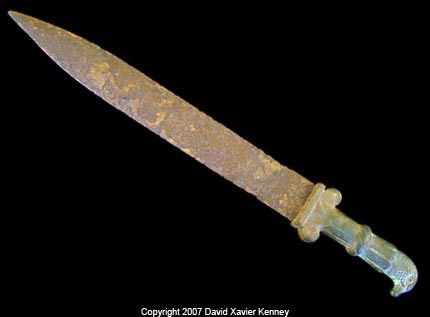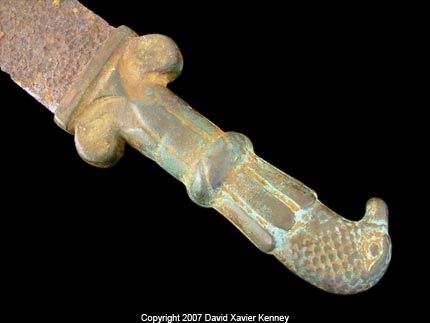Roman High Ranking Officer's Parazonium Short Sword
Jul 20, 2014 4:29:55 GMT
Post by Jack Loomes on Jul 20, 2014 4:29:55 GMT



Length: 43.8 cm
Hilt: 12.7 cm
Blade Width (at the hilt): 4 cm
Material: Iron, Bronze, Silver (With traces of gold gilding), and fossilized Wood
Era: Mid to Late 1st AD
Culture: Roman Provincial
Origin: From an Antiquities Dealer in California
After much study it appears that I may now have the answers as to the mystery of at least some of the meaning of the Roman Parazonium. The fact that the blade is completely functional and other factors suggests that the blade had in fact once been on a Field Parazonium (seen on statue relief's as tucked into a tied cloth band in front half way up the torso) that had been worn into battle, perhaps primarily as a symbol. The fact that the hilt is to heavy for anything other the carriage with the point up, suggests that the Field Parazomium's blade after a battle had been inserted into a heavy hilt for parades and official functions to be carried as a status symbol.
An Early 2nd C. AD Knife with an Eagle-Headed Hilt was discovered by Archeologist and collector Marcel Julsing. It may be of a type that had been a weapon of status that was worn by a Parazonium owner. The hilt is bronze (this may have once been gold gilded) with an iron blade, it is 23.5 cm in total length and shows some of the same design themes and iconography as the Parazonium sword (or long dagger) just viewed. The knife though small in size shows that it is functional and would have also had utility for a soldier in the field. The hilt bears a remarkable resemblance to a Parazonium tucked into an aristocrat's torso sash, worn by a Roman Officer portrayed on Trajan's column. The grip and guard are in the shape of a Corinthian column. A portion of both the grip and pommel appear as a type of plant shoot (a fennel shoot?) with an eagle's head facing forward. The blade's shape could suggest an eagle's talon. The overall shape of the knife gives the impression that it may represent a streaking meteor or comet. It appears that this knife has much of the same meaning as the Parazonium, the blade is either of meteorite iron or contains at least some meteorite iron. From pictures of the Parazonium, Marcel speculates that this knife and the Parazonium may have been found together, or in the same general vicinity. To my knowledge this is the only known example. To view this Parazonium hilted knife Click here.
Archeologist and collector Marcel Julsing of the Netherlands specializes in Carolingian Era research and artifacts. He has an extensive Medieval collection and a collection of rarities of various eras. If you would like to contact Marcel he can be emailed at: narimaan@hetnet.nl or bodemvondsten@hetnet.nl
Source: romanofficer.com/PermcolABU081212.htm#field_parazonium

.png?width=1920&height=1080&fit=bounds)